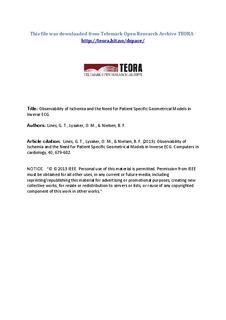| dc.contributor.author | Lines, Glenn Terje | |
| dc.contributor.author | Lysaker, Ola Marius | |
| dc.contributor.author | Nielsen, Bjørn Fredrik | |
| dc.date.accessioned | 2014-12-10T13:36:12Z | |
| dc.date.accessioned | 2017-04-19T12:52:36Z | |
| dc.date.available | 2014-12-10T13:36:12Z | |
| dc.date.available | 2017-04-19T12:52:36Z | |
| dc.date.issued | 2013-09 | |
| dc.identifier.citation | Lines, G. T., Lysaker, O. M., & Nielsen, B. F. (2013). Observability of Ischemia and the Need for Patient Specific Geometrical Models in Inverse ECG. Computers in cardiology, 40, 679-682. | |
| dc.identifier.isbn | 978-1-4799-0884-4 | |
| dc.identifier.issn | 2325-8861 | |
| dc.identifier.uri | http://hdl.handle.net/11250/2438560 | |
| dc.description.abstract | We have performed ECG simulations on four realistic geometries in order to quantify the effect of ischemic location in the left ventricle in terms of ST shifts in the body surface potential (BSP). Using 64 electrodes we found that most segments were clearly visible on at least some of the electrodes, although signals were generally weaker from the left side of the heart. We also found that cancelling effects can occur when more than one ischemic area is present. Significant inter-patient difference where observed, demonstrating the need for patient specific geometries. Within groups of imilar body type the results were highly correlated, indicating that it is probably enough to use approximative geometries. | |
| dc.language.iso | eng | |
| dc.publisher | IEEE | |
| dc.subject | Electrocardiography | |
| dc.subject | Biological system modeling | |
| dc.subject | Computational modeling | |
| dc.subject | ECG simulations | |
| dc.title | Observability of Ischemia and the Need for Patient Specific Geometrical Models in Inverse ECG. | |
| dc.type | Journal article | |
| dc.type | Peer reviewed | |
| dc.description.version | Accepted version | |
| dc.subject.nsi | 620 | |
